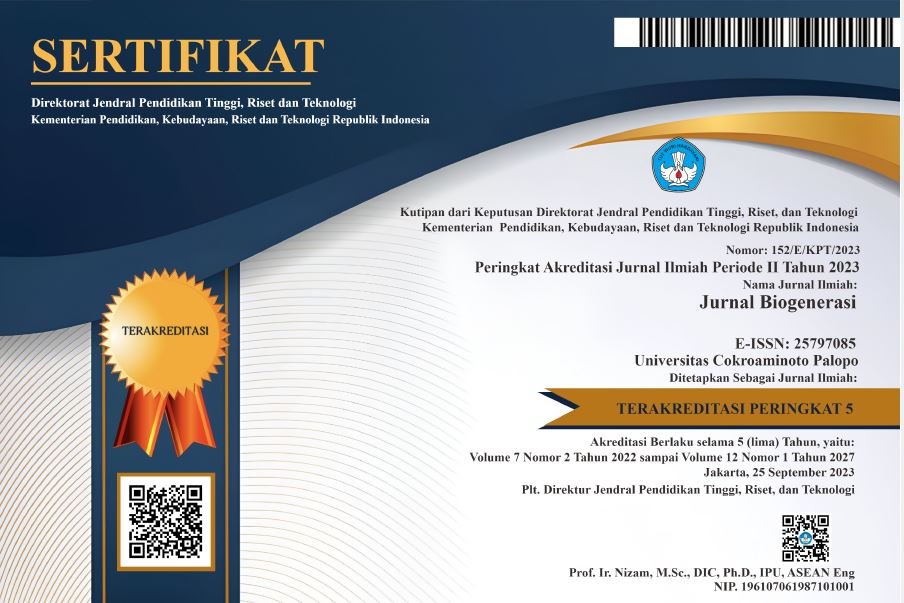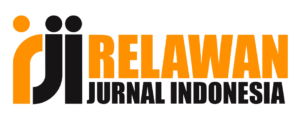PENGARUH MODEL PEMBELAJARAN CONCEPT ATTAINMENT TERHADAP AKTIVITAS DAN HASIL BELAJAR MAHASISWA PADA MATA KULIAH EPIDEMIOLOGI MATERI MORBIDITY MEASUREMENT
DOI:
https://doi.org/10.30605/biogenerasi.v7i2.1947Keywords:
concept attainment, learning model, morbidity measurementAbstract
This study aims to determine the activities and learning outcomes of students before and after the application of the concept attainment learning model in the epidemiology subject on morbidity measurement, and to determine the effect of the concept attainment learning model on the fourth semester student learning outcomes in the Science Education Study Program. This research is a quasi-experimental research. The research design used is a pretest-posttest control group design with purposive sampling technique. From the results of the study, it was found that after the application of the concept attainment learning model, students were more active and enthusiastic. Student learning outcomes after the application of the concept attainment learning model are in the high category, namely 52.95% with an average value of 81.97. It can be concluded that there is an influence of the concept attainment learning model on learning activities and learning outcomes in the fourth semester students of the Science Education Study Program, known from the average value of 81.97 and is included in the high category.
Downloads
References
Arikunto, Suharsimi. 2008. Prosedur Penelitian: Suatu Pendekatan Praktik. Jakarta: Rineka Cipta.
Bustan. M.N. 1997. Pengantar Epidemiologi. Jakarta: Rineka Cipta.
Chonticha, Lekpoonkird. 2012. “Active and Passive Voices through Concept Attainment Model (CAM) a Case of Mathayom 1 Students”.
David, Richard Moore. 2011. “Selecting Evaluation Items for Judging Concept Attainment in Instructional Design”, vol 5 no 1diakses dari http:// www.ncolr.org/.../selecting-evaluation-items- for-judging-co
Ertikanto, Chandra. 2016. Teori Belajar dan Pembelajaran, Yogjakarta: Media Akademi.
Golnaz Ostad, Javad Soleymanpour. 2015. “The Impact of Concept Attainment Teaching Model and Mastery Teaching Method on Female High School Students' Academic Achievement and Metacognitive Skills”, Vol 3. No.2
Indriana, Dina. 2011. Mengenal Ragam Gaya Pembelajaran Efektif, Jogjakarta: Diva Press.
Joy R, Mayer. 2014. “Effects of Using The Concept Attainment Model With Inductive Reasoning With High School Biology Students”, diakses dari https://scholarworks .montana.edu/.../1/.../MayerJ0812.pdf?
Muh.khalifah Mustami, Suryadin dan Ismail Wekke. 2016. “Learning Model Combine with Mind Mapping and CooperativeStrategies for Junior High School Student”
Mustafi, Muhammad Khalifah. 2015. Metodelogi Penelitian Pendidikan: Yogyakarta.
Mustafi, Muhammad Khalifah, Mardiana Suyuti dan Maryam, “Validy, Practicality, And Effectivenes Of Biology Learning Devices Integration Of Islam Spiritual”, vol 23, no. 1, diakses dari www.jurnalalqalam.or.id/index.php/ Alqalam/article/view/392/277, pada tanggal 23 Juni 2022.
Ningsih Dwi Pangestu, Wahono Widodo, “Penerapan Model Pembelajaran Berbasis Masalah Sebagai Upaya Meningkatkan Aktivitas Dan Hasil Belajar Mahasiswa Pada Mata Pelajaran Ipa Kelas Iv Sdn Balas Klumprik I/434 Surabaya”, vol 1, no. 2, diakses dari http://jurnalmahasiswa.unesa.ac.id>view, pada tanggal 23 Juni 2022.
Risdawati. 2017. Pengaruh Model Pembelajaran Concept Attainment terhadap aktivitas dan hasil belajar mahasiswa pada pelajaran Biologi Materi Sel di kelas XI SMA Negeri 11 Bulukumba. Universitas Islam Negeri Makasar: Skripsi tidak diterbitkan
Saefuddin, Aziz dan Berdiati, Ika. 2014. Pembelajaran Efektif. Bandung: PT Remaja Rosdakarya.
Shaikh, Kashefa Anjum. 2005. “Studi Pengaruh Model Konsep Intainment Terhadap Pencapaian Konsep Geometri VIII Standar Mahasiswa Bahasa Inggris Mahasiswa Medium Kota Aurangabad”, vol 2, no 15.
Shi, L. 2008. Health Services Research Methods. 2nd ed. Delmar Learning, New York. Pp. 57-58.
Subana. 2000. Statistik Pendidikan. Bandung:CV Pustaka Setia.
Sudijono, Anas. 2010. Statistik Pendidikan. Jakarta: Raja Grafindo Persada.
Sudjana, Nana. 2004. Dasar-Dasar Proses Belajar Mengajar (Bandung: Sinar Baru Algesindo.
Sugiyono. 2008. Metode Penelitian : Pendekatan Kuantitatif, Kualitatif Dan R&D. Bandung: Alfabeta.
Syella, Ayunisa Rani dan Yusman, Wiyatmo. 2012. “Development Of Student Worksheet With Conceptual Attainment Method To Improve Concepts Understanding And Science Process Skills In Equilibrium And Rotational Dinamics” vol 5 no.4 diakses dari http:// journal.student.uny.ac.id/ ojs/index.php/pfisika/article/download/1001/5899.
S. A. Rani, Y. Wiyatmo, dan H. Kustanto. 2016. “Concept Attainment Worksheet to Enhance Concept Knowledge and Science Process Skills in Physics Instruction”.
Tiro, Muh. Arief. 2010. Dasar-Dasar Statistik (Cet. II; Makassar: State University of Makassar Press.
Yani Riyani. 2013. “Faktor-faktor yang Mempengaruhi Prestasi Belajar Mahasiswa (Studi pada mahasiswa Jurusan Akuntansi Politeknik Negeri Pontianak)”, Vol 8. No 1 diakses dari mobile.repository.polnep.ac.id/xmlui/bitstream/handle/.../354/03-YANI%20R.pdf
Downloads
Published
How to Cite
Issue
Section
License
In submitting the manuscript to the journal, the authors certify that:
- They are authorized by their co-authors to enter into these arrangements.
- The work described has not been formally published before, except in the form of an abstract or as part of a published lecture, review, thesis, or overlay journal.
- That it is not under consideration for publication elsewhere,
- That its publication has been approved by all the author(s) and by the responsible authorities – tacitly or explicitly – of the institutes where the work has been carried out.
- They secure the right to reproduce any material that has already been published or copyrighted elsewhere.
- They agree to the following license and copyright agreement.
License and Copyright Agreement
Authors who publish with this journal agree to the following terms:
- Authors retain copyright and grant the journal right of first publication with the work simultaneously licensed under Creative Commons Attribution License (CC BY 4.0) that allows others to share the work with an acknowledgment of the work's authorship and initial publication in this journal.
- Authors are able to enter into separate, additional contractual arrangements for the non-exclusive distribution of the journal's published version of the work (e.g., post it to an institutional repository or publish it in a book), with an acknowledgment of its initial publication in this journal.
- Authors are permitted and encouraged to post their work online (e.g., in institutional repositories or on their website) prior to and during the submission process, as it can lead to productive exchanges, as well as earlier and greater citation of published work.


.png)

